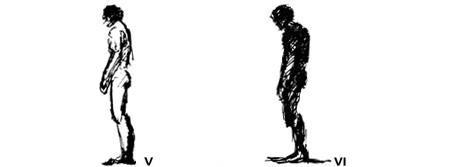Congenital predominance of the frontal osei: forward-backward taiheki, types five and six
When the frontal osei + (V) is predominant by taiheki, the following physical structure is formed:
The formation of both the shoulders and the chest cavity stands out. The development of the head is particularly remarkable at the front. The face is square-shaped due to the head formation and to the large developed jaws. The neck is robust and it sits on the trunk projecting itself straight forward in the f-e plane. The volume of the thorax expands bilateralwards. The hips are small and narrow. The buttocks are strong, they jut slightly backwards and they can have an extraordinary free movement (especially in the f-e direction). The overall CVP is inverted triangle-shaped (anterior view) due to the narrow hips and extremely broad shoulders that look like coat-hangers. The upper and lower extremities are long and their muscles are extremely developed. The hands, feet, fingers, toes, and all their corresponding joints (elbows, wrists, knees, ankles, etc.) are very strong as a result of the muscular nature of the CVP and of all the extremities. All this structure has a fibrous, muscular, and athletic look.
This structure gets activated from the dorsal area of the CVP due to the A tension that is channelled through it. This A tension activates. among other tissues, the frontal series of muscles connected to the semispinalis capitis, the angular (levator of the shoulder blade), the longissimus dorsi, and the pectoralis major.
The predominance of the frontal osei VI (–) by taiheki is responsible for a structure similar to that in osei + (V) except for the following differences:
The shoulders, which are largely developed and open out in osei V, are locked (forward and inwards). The volume of the thorax does not expand in the bilateral plane as much as in osei V. The inverted triangle shape of the CVP is smaller.
This structure is activated from the ventral area of the CVP as a result of the A tension that is channelled through it. This A tension activates, among other tissues, the same series of muscles as those in osei + (V), connected to the anterior part of the longitudinal portion of the longissimus cervicis, to the scalenus medius, and to the pectoralis minor in relation to the psoas major.
 predominance of the frontal osei + predominance of the frontal osei –
predominance of the frontal osei + predominance of the frontal osei –
When the accumulated tension resulting from not being able to fulfil or express the desire of the pragmatic psyche becomes excessive partial tension, the following symptoms appear:
- fatigue or general muscular heaviness;
- stiffness in the tissues organised around vertebrae Th3-Th4, L5 and Th7 and back pain;
- a knot at the centre of the pit of the stomach that reduces the chest-abdominal breathing;
- need to relax and sleep due to the EPT on the shoulders;
- mild and chronic asthma (only when osei VI is predominant).
At the psychic level the following type of obsession appears:
- anxiety or obsession caught by the internal over-excitation of some brain activity which always acts in a hasty way;
- excessive fear or continuous restlessness of unknown origin but having to do with the fact that the breathing is blocked at the level of the shoulders; breathing does not arise from the lower area of the abdomen (this state of discomfort is similar to the restlessness we feel when we need to evacuate).


